|
| On 19 July 1619 commander Frederik de Houtman sailing
on board Dordrecht, skippered by Reyer Jansz, and the Amsterdam under
skipper Maarten Cornelisz, struck upon ‘the Southland lying
behind Java’, much further south than the ships before
them. On board the Amsterdam was the Councillor of the Indies,
Jacob Dedel. The new land was named Dedelsland after him as
the highest ranked person.
The weather did not allow closer examination and the two ships
sailed north, keeping far out from shore. On 29 July, de Houtman
discovered several low islands surrounded by extensive coral
reefs.
The position of these islands was accurately plotted and as
a warning they were named De Houtman Abrolhos, meaning ‘look
out’. |

Right: Aerial view
of Pelsaert
Island, Houtman Abrolhos.
Photo: Patrick Baker,
Western Australian Museum.
|
This warning, however, did not prevent the loss of
two Dutch East India Company ships in the Houtman Abrolhos some
years later — Batavia in 1629 and Zeewijk in
1727. In their letters home, de Houtman and Dedel’s mention
of gold made their masters extremely interested in the new land
and keen to investigate futher.
Although the VOC took every measure
to keep the sailing routes secret, competitors inevitably got
to know about them. In 1622 the English East India Company
ship Trial tried to follow the new south route but the voyage ended
in catastrophe off the Monte Bello Islands.
‘This Southland, it seems to be fine
country as we could see…’
‘…one should stay clear of this shoal, for it
lies most treacherously for ships that want to call in at this
land. It is at least 10 mijlen long; lies at 28 degress, 26 minutes.’
Frederik de Houtman
'The Land of Eendracht looked to be red,
clayish land, and, according to some people’s description,
could be found to be rich in gold…’ Jacob Dedel

Nova Totius Terrarum Orbis Geographica AC
Hydrographica Tabula, 1630
First
published in ‘Atlantis Maioris Appendix’.
Amsterdam, 1631
Hendrik Hondius
Hondius’ twin globe map of the world, with its elaborately
drawn margins and portraits of Mercator, Caesar, Ptolemy and Jodocus
Hondius in the corners, is the first dated map in an atlas to show
any part of Australia. Charted are the 1623 discoveries of Dutchman
Jan Carstensz on the west coast of Cape York Peninsula.
For first time on a widely available printed world map, the early
Dutch discoveries of Australia are shown. This map is a watershed
in the history of the mapping of Australia.
Hondius lists place names on Australia’s west coast
indicative of the discoveries of Hartog and de Houtman
including Dirk Hartog's ree and T. Lant van Eendracht, F Houtmans
arbrooleus and Dedelis landt.
On loan from Jock Clough Collection |


